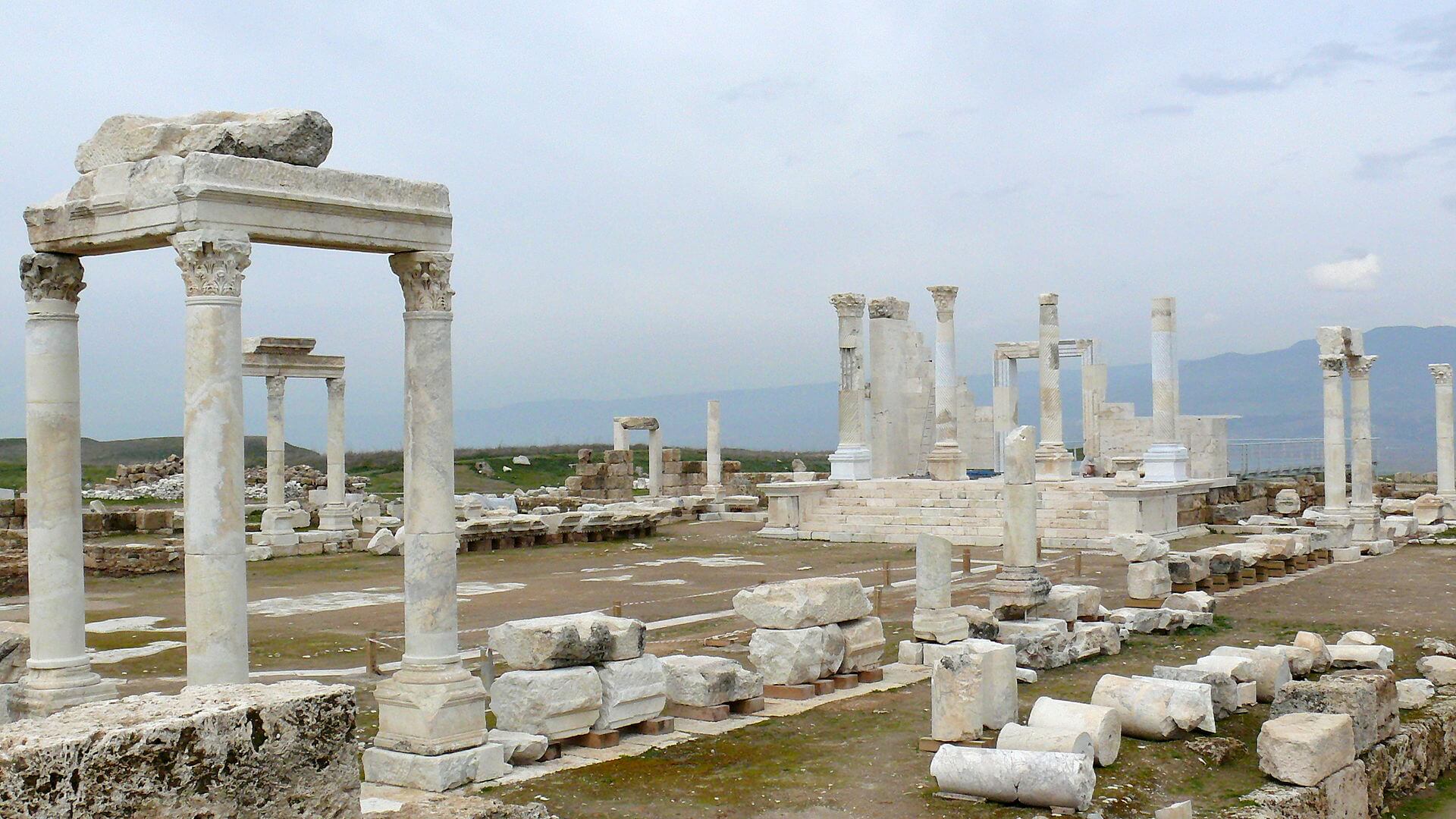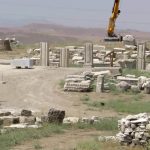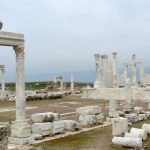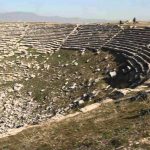HISTORY OF LAODICEA
Laodicea occupies a broad plateau overlooking the fertile valley of the River Lycus (Greek: Lykos) tributary of the Maeander. Lying far inland from the major archaeological sites on the Aegean coast, it has emerged only in the last decade as the second largest Roman city in Anatolia, exceeded only by Ephesus. Dormant since it was abandoned in the late middle Ages, it was known mainly through biblical and literary sources. Since 1993 archaeologists have discovered new evidence of a thriving metropolis. In ten years they have revealed the Hippodamian grid plan and so much remarkable architecture that UNESCO has placed the site on the World Heritage Temporary List. As excavation and restoration continue, visitors will experience even more evidence of this prosperous metropolis. It is 16 km. from the World Heritage Site of Hierapolis (Pamukkale) and about the same distance from the important classical city of Colossae where almost nothing remains.
.
HISTORY
Abundant pottery and obsidian blades prove that the area was inhabited as early as the fourth millennium BCE. Long before any urban development, indigenous people farmed the rich agricultural land; they produced ample crops and grew prosperous raising sheep. The soft, raven-black wool that they produced was prized for its fine quality. At an unknown date the city of Diospolis, dedicated to Zeus, was established on the site. In the middle of the third century BCE Antiochus II Theos (280-261 BCE), the grandson of Seleucus (one of the Diadochi) founded the new city of Laodicea (or Laodikeia) on the same site, naming it after his wife Laodice. It was one of five cities he named in her honor.
.
Antiochus spent much of his reign at war with Ptolemy II of Egypt, in a struggle for control of territory in the eastern Aegean. He also devoted time to the founding of several cities, always giving careful thought to their siting. In the case of Laodicea, the combination of fertile land and the crossing of major highways made the location an excellent choice. The trade route running east from Ephesus up the Maeander valley came to this place known as the Gates of Phrygia, where the river flowed through a dangerous, narrow gorge. This geological obstacle forced the highway to divert through Laodicea, entering through the Ephesian Gate and leaving by the Syrian Gate. It then continued east into central Anatolia and southeast to the Euphrates. The busy road from Sardis leading south to the Mediterranean coast crossed it not far outside the city.
.
The intersection of these two important routes proved crucial for promoting trade. Laodicea not only developed a reputation for wool and garments manufactured in the city, it also became a great financial center. In 252 BCE Antiochus swelled the population of Laodicea when he moved about two thousand Jewish families from Mesopotamia to Phrygia; many of them settled in the new city. Eventually, in 261 BCE he made peace with Ptolemy, divorced Laodice and married Ptolemy’s daughter Berenice. However, the name of Laodicea remained unchanged.
.
In 188 BCE this city, like most others in the region, came under the rule of Pergamon and, on the death the last Pergamene king Attalos III in 133 BCE, was absorbed into the Roman Empire. This change brought new opportunities and, despite occasional involvement in wars, Laodicea thrived under Roman administration. It soon became the principal banking center in Roman Asia. Taxes from as far away as Syria and Palestine were brought here to be transmitted to Rome.
.
In 50 BCE the Roman scholar of Greek philosophy and statesman Cicero came to Laodicea for a few months as a judge and rectified injustices perpetrated by a tyrannical predecessor. Amazingly he took advantage of the advanced banking system to cash letters of credit there. Shortly after his visit, the city was caught up in the conflict between Caesar and Pompey, but quickly recovered. A devastating earthquake in 60 CE caused severe damage but according to the Roman historian Tacitus, the Laodiceans displayed their wealth and independence by rejecting help from Rome for the rebuilding. When Emperor Hadrian visited the city in 129 CE, he would have found it at the height of its architectural splendor.
.
Despite Laodicea’s position between two small rivers, the Asopus and the Caprus, which flowed into the Lycus, the ground yielded insufficient water to support the population. In fact, these rivers dried up in the sum-mer. The Romans demonstrated their engineering talents by building an aqueduct and laying travertine pipes from a spring 8 km. to the south, near present-day Denizli. It flowed, under pressure, to a water tower on the south side of the city just east to the stadium and from there was distributed through underground pipes. With typical Roman ostentation, they celebrated its abundance by building four nymphaea where it splashed into pools for public enjoyment. The calcium in the water quickly clogged the pipes, so they made openings in them with removable stone caps to give access for cleaning. Many pipes discovered on the site are almost entirely closed by white mineral deposits.
.
Laodicea also gained fame for its medical school, originally at the nearby temple of the Anatolian moon god Men. Its teachers followed the scientific method of Herophilos of Alexandria (born in Chalcedon), the author of nine important medical texts. Galen, the famous physician of Pergamon praised the school and gave special mention to an eye salve made there from ‘Phrygian powder’ (finely ground stone) and oil, as well as a remedy for diseases of the ears. During the reign of Augustus the doctors Alexander Philaletas and Xeuxis were so well respected that their name appeared on coins with the staff of Hermes, a symbol of healing, and the head of Augustus on the other side.
.
JEWISH AND CHRISTIAN ERA
The strength of the Jewish population in Laodicea can be calculated by the amount of gold that its members collected in 62 BCE for the rebuilding of the temple in Jerusalem. Since Jews were taxed for this purpose at a rate of a half shekel per person, the population appears to have included about 7,500 men as well as women and children. Although the Roman authorities generally awarded rights to Jews, the proconsul Flaccus confiscated the gold, on the grounds that it should not leave the country. In contrast, Augustus issued a decree in about 2 CE enforcing Jewish rights in Asia.
.
The presence of so many Jews made the populace of Laodicea relatively receptive to Christianity. St. Paul never visited the city but during his time in Ephesus around 54 BCE he was in contact with church leaders there. By the time that St. John the Divine wrote the New Testament book the Revelation (ca. 70 to 90 CE), the congregation must have been considerable. John named Laodicea as one of the seven churches of Asia.
.
In about 363 CE, four decades after Emperor Constantine convened the Council of Nicea, the bishops of Roman Asia were summoned to the Synod of Laodicea. Its purpose was to develop rules or canons for the conduct of the church. They dealt with such issues as modest behavior, liturgical practices, and the observance of Lent. One decision was to for-bid the practice of astrology which had not previously been, proscribed by church authorities. In the early centuries after the time of Christ many Christians attended synagogues but a significant canon delivered by the synod created a distance between Jews and Christians by forbidding Christians from observing the Jewish Sabbath.
.
The principal church of Laodicea, probably constructed soon after 413 CE, when the practice of Christianity became legal in in the Roman Empire, is believed to be the seventh oldest in the world. Its site has not yet been identified with certainty, but a large basilica church between the two theatres and a cruciform church a little west of the Agora provide examples of church building activity in the Byzantine era. Other places of Christian worship are likely to emerge as excavations proceed.
.
Emperor Theodosius (378-395 CE) bolstered the defenses by sur-rounding the urban area with walls and building new fortified gates on the four main highways leading out of the urban area. But earthquakes presented a greater threat than invaders. The citizens rebuilt many times after seismic damage, but this great metropolis never recovered from an earthquake in the early seventh century that also wreaked havoc in Aphrodisias and Hierapolis. The water supply system was damaged; most of the inhabitants moved to a nearby town. When Seljuk and Turcoman invaders came to the region in the early twelfth century, the Byzantine Empire was already declining and little remained to defend.
Laodicea

Categories :
Turkey Tours and Travel


